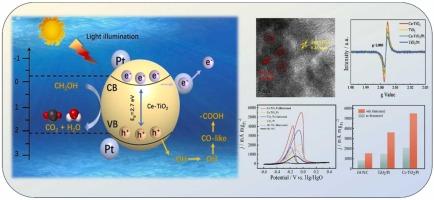用于高效光电催化甲醇氧化的富氧空位 Ce 掺杂二氧化钛支撑铂纳米粒子
IF 6.3
2区 材料科学
Q2 CHEMISTRY, PHYSICAL
引用次数: 0
摘要
在电催化过程中,昂贵的铂催化剂容易中毒,但铂和载体之间的界面相互作用有望克服中毒现象,提高催化活性。关键是要设计出高效的载体。本文采用溶胶-凝胶法制备了掺有Ce的TiO2载体(Ce-TiO2/Pt),该载体含有氧空位负载的铂纳米颗粒,随后进行了化学还原。Ce-TiO2/Pt 纳米复合催化剂的表征采用了多种技术,如 SEM、TEM、XRD、XPS、EPR、UV-vis DRS、BET 和电化学。制备的 Ce-TiO2/Pt 在碱性介质中对甲醇氧化的电催化活性为 2070 mA mg-1,在光照条件下催化活性显著提高到 5505 mA mg-1。与 TiO2/Pt 和商业 JM Pt/C 催化剂相比,Ce-TiO2/Pt 具有更高的光电催化活性、耐中毒能力和长期稳定性,这主要归功于掺杂 Ce 后氧空位的增加、电子结构的优化和形貌的良好控制。这项研究为开发低成本、耐用、高性能的直接甲醇燃料电池催化剂提供了一条新途径。本文章由计算机程序翻译,如有差异,请以英文原文为准。

Abundant Oxygen Vacancies Ce-Doped TiO2 Supported Pt Nanoparticles for High-Efficiency Photoelectrocatalytic Methanol Oxidation
In electrocatalysis, the expensive Pt catalysts are prone to poisoning, but the interface interaction between Pt and carrier is expected to overcome poisoning and improve catalytic activity. The key is to design efficient carriers. Herein, a Ce-doped TiO2 carrier with oxygen vacancies loaded Pt nanoparticles (Ce-TiO2/Pt) was prepared by sol-gel and subsequent chemical reduction. Ce-TiO2/Pt nanocomposite catalysts are characterized by various techniques such as SEM, TEM, XRD, XPS, EPR, UV-vis DRS, BET, and electrochemistry. As-prepared Ce-TiO2/Pt exhibited electrocatalytic activity of 2070 mA mg-1 towards methanol oxidation in an alkaline medium, and the catalytic performance was significantly enhanced to 5505 mA mg-1 under light conditions. Compared to TiO2/Pt and commercial JM Pt/C catalysts, the superior photoelectrocatalytic activity, poisoning-tolerance ability, and long-term stability of Ce-TiO2/Pt was mostly responsible for the rise in oxygen vacancies, optimization of the electronic structure, and favorable control of morphology after Ce doping. This study provides a new pathway for advancing low-cost, durable, exceptional-performance catalysts for direct methanol fuel cell.
求助全文
通过发布文献求助,成功后即可免费获取论文全文。
去求助
来源期刊

Journal of Alloys and Compounds
工程技术-材料科学:综合
CiteScore
11.10
自引率
14.50%
发文量
5146
审稿时长
67 days
期刊介绍:
The Journal of Alloys and Compounds is intended to serve as an international medium for the publication of work on solid materials comprising compounds as well as alloys. Its great strength lies in the diversity of discipline which it encompasses, drawing together results from materials science, solid-state chemistry and physics.
 求助内容:
求助内容: 应助结果提醒方式:
应助结果提醒方式:


